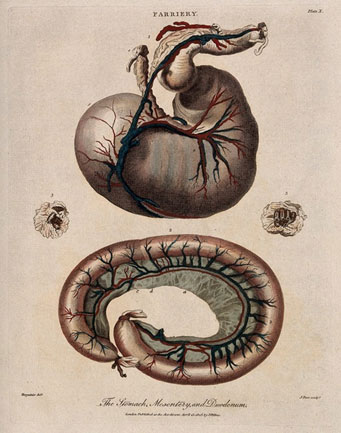Written by Darian Livingstone | Ceres Industries
(306) 653-7258 |

Segments of a horse's digestive tract including the stomach and hindgut.
Colic refers to pain in the horse's abdomen and is actually a symptom rather than a condition. Colic usually occurs when there is a disruption in the hindgut flora or gut motility, resulting in impaction or gas build up. Horses evolved to be grazers, consuming small amounts of forages throughout the day, much like cattle. However, over the years, in an attempt to maximize performance, particularly in athletic horses, horse owners have moved towards diets containing less fibre and more concentrates. Abrupt changes in diets, improper ratios of forages to grains, or spoiled feed can lead to colic.
Horse owners can reduce colic by mimicking nature when feeding or getting as close to it as possible. A turnout paddock with constant access to grasses and forage is the most ideal, with small quantities of grain offered if the work level requires it.
Horses that are kept in stalls are at a higher risk of colic because of decreased activity. Horses will naturally wander around while they graze in a pasture, whereas they obviously can't do so in a barn. Gut motility is encouraged by exercise and activity. If confinement is necessary, horse owners should maximize the level of forages.
Some performance horses living in stalls receive higher grain and supplement diets. Meals are often delivered twice a day, one in the morning and one in the afternoon. Smaller, more frequent portions of grain will reduce the risk of colic. High grain diets don't spend enough time in the stomach and small intestines before reaching the hindgut - the location for fermentation and nutrient absorption. This means that large amounts of undigested grain (sugar) are bombarding the hindgut designed to digest grass, negatively impacting the microbial population.
This shift in microbes creates an increased production of gas. While cows have an easier time dealing with bloat because of their rumen's forward location, horses, on the other hand, do not have it that easy. When high sugar diets cause excess gas build-up, it can create pressure and pain (colic).
Providing your horse with lots of water, especially in the winter when water intake decreases. Impactions or increases in transit time through the GI tract often result in a lack of moisture within, causing coarse material to build up. Dr. Warren, with The Horse, states that there is an incredibly large amount of water that moves in and out of the GI tract. Each day, the average horse absorbs about 31.5 gallons of water from various regions of the hindgut.
Finding supplements with prebiotics or yeast can help to prevent colic in horses by helping to maintain the microbial population and prevent excess gas build up. Saltec Fortified Pro contains fermentation extract meant to maintain gut health.
By supplying clean water, turning horses out regularly for exercise, and making gradual changes to a diet, horse owners can help prevent colic.
References
Kentucky Equine Research. 2014. Nutritional Factors in Equine Colic. Kentucky Equine Research. [blog] https://ker.com/equinews/nutritional-factors-equine-colic/
Thomas, H. 2017. Feeding to Prevent Colic. The horse. [blog] https://thehorse.com/120139/feeding-to-prevent-colic/

